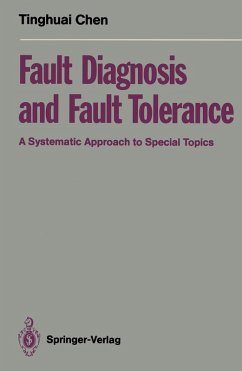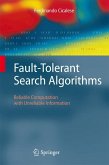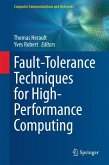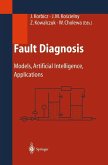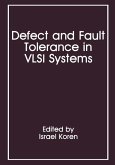Tinghuai Chen
Fault Diagnosis and Fault Tolerance (eBook, PDF)
A Systematic Approach to Special Topics
72,95 €
72,95 €
inkl. MwSt.
Sofort per Download lieferbar

36 °P sammeln
72,95 €
Als Download kaufen

72,95 €
inkl. MwSt.
Sofort per Download lieferbar

36 °P sammeln
Jetzt verschenken
Alle Infos zum eBook verschenken
72,95 €
inkl. MwSt.
Sofort per Download lieferbar
Alle Infos zum eBook verschenken

36 °P sammeln
Tinghuai Chen
Fault Diagnosis and Fault Tolerance (eBook, PDF)
A Systematic Approach to Special Topics
- Format: PDF
- Merkliste
- Auf die Merkliste
- Bewerten Bewerten
- Teilen
- Produkt teilen
- Produkterinnerung
- Produkterinnerung

Bitte loggen Sie sich zunächst in Ihr Kundenkonto ein oder registrieren Sie sich bei
bücher.de, um das eBook-Abo tolino select nutzen zu können.
Hier können Sie sich einloggen
Hier können Sie sich einloggen
Sie sind bereits eingeloggt. Klicken Sie auf 2. tolino select Abo, um fortzufahren.

Bitte loggen Sie sich zunächst in Ihr Kundenkonto ein oder registrieren Sie sich bei bücher.de, um das eBook-Abo tolino select nutzen zu können.
The diagnosis of faults in VLSI chips and the design of chips to be fault-tolerant form the subject of this book. Seven topics are treated at a level appropriate for researchers beginning work in the field. The treatment is formal enough to be widely applicable.
- Geräte: PC
- ohne Kopierschutz
- eBook Hilfe
- Größe: 27.56MB
Andere Kunden interessierten sich auch für
![Switching Theory for Logic Synthesis (eBook, PDF) Switching Theory for Logic Synthesis (eBook, PDF)]() Tsutomu SasaoSwitching Theory for Logic Synthesis (eBook, PDF)112,95 €
Tsutomu SasaoSwitching Theory for Logic Synthesis (eBook, PDF)112,95 €![Fault-Tolerant Search Algorithms (eBook, PDF) Fault-Tolerant Search Algorithms (eBook, PDF)]() Ferdinando CicaleseFault-Tolerant Search Algorithms (eBook, PDF)40,95 €
Ferdinando CicaleseFault-Tolerant Search Algorithms (eBook, PDF)40,95 €![Fault-Tolerance Techniques for High-Performance Computing (eBook, PDF) Fault-Tolerance Techniques for High-Performance Computing (eBook, PDF)]() Fault-Tolerance Techniques for High-Performance Computing (eBook, PDF)72,95 €
Fault-Tolerance Techniques for High-Performance Computing (eBook, PDF)72,95 €![Computational Intelligence in Fault Diagnosis (eBook, PDF) Computational Intelligence in Fault Diagnosis (eBook, PDF)]() Computational Intelligence in Fault Diagnosis (eBook, PDF)112,95 €
Computational Intelligence in Fault Diagnosis (eBook, PDF)112,95 €![Fault Diagnosis (eBook, PDF) Fault Diagnosis (eBook, PDF)]() Fault Diagnosis (eBook, PDF)232,95 €
Fault Diagnosis (eBook, PDF)232,95 €![Defect and Fault Tolerance in VLSI Systems (eBook, PDF) Defect and Fault Tolerance in VLSI Systems (eBook, PDF)]() Israel KorenDefect and Fault Tolerance in VLSI Systems (eBook, PDF)72,95 €
Israel KorenDefect and Fault Tolerance in VLSI Systems (eBook, PDF)72,95 €![The Discrete Math Workbook (eBook, PDF) The Discrete Math Workbook (eBook, PDF)]() Sergei KurgalinThe Discrete Math Workbook (eBook, PDF)36,95 €
Sergei KurgalinThe Discrete Math Workbook (eBook, PDF)36,95 €-
-
-
The diagnosis of faults in VLSI chips and the design of chips to be fault-tolerant form the subject of this book. Seven topics are treated at a level appropriate for researchers beginning work in the field. The treatment is formal enough to be widely applicable.
Dieser Download kann aus rechtlichen Gründen nur mit Rechnungsadresse in A, B, BG, CY, CZ, D, DK, EW, E, FIN, F, GR, HR, H, IRL, I, LT, L, LR, M, NL, PL, P, R, S, SLO, SK ausgeliefert werden.
Produktdetails
- Produktdetails
- Verlag: Springer Berlin Heidelberg
- Seitenzahl: 197
- Erscheinungstermin: 6. Dezember 2012
- Englisch
- ISBN-13: 9783642771798
- Artikelnr.: 53290038
- Verlag: Springer Berlin Heidelberg
- Seitenzahl: 197
- Erscheinungstermin: 6. Dezember 2012
- Englisch
- ISBN-13: 9783642771798
- Artikelnr.: 53290038
- Herstellerkennzeichnung Die Herstellerinformationen sind derzeit nicht verfügbar.
The diagnosis of faults in VLSI chips and the design of chips to be fault-tolerant form the subject of this book. Seven topics are treated at a level appropriate for researchers beginning work in the field. The treatment is formal enough to be widely applicable.
1 Four-Valued Logic and Its Applications.- 1.1 Introduction.- 1.2 Mathematical Basis.- 1.3 STAR Expansions, Boolean Difference and Boolean Differential.- 1.4 Combined Components.- 1.5 Boolean Equations.- 1.6 Test Generation for Combinational Circuits.- 1.7 Statical Test Generation for Sequential Circuits.- 1.8 Identification of Hazards and Dynamic Testing.- 1.9 Transition Logic.- 1.10 Comparison with Other Logics.- References.- 2 Computer System Diagnosis and Society Diagnosis.- 2.1 Introduction (PMC Model).- 2.2 One Step System Diagnosis for PMC Model.- 2.3 The Extension of System Diagnosis.- 2.4 The Application of System Diagnosis.- References.- 3 Testability Design via Testability Measures.- 3.1 Introduction.- 3.2 Testability Design.- 3.3 Design for Testability at Module Level.- 3.4 Applications.- References.- 4 NMRC: A Technique for Redundancy.- 4.1 Introduction.- 4.2 NMRC System Model.- 4.3 Analysis of Fault Tolerance Capability.- 4.4 Optimal NMRC System Design.- 4.5 An Example for Comparison Analysis.- 4.6 Conclusion.- References.- 4.A.1 The Proof of Theorem 4.4.- 4.A.2 The Proof of Lemma 2.- 5 Fault Tolerance of Switching Interconnection ß-Networks.- 5.1 Introduction.- 5.2 General Inequalities.- 5.3 ISE-MISE-RMISE.- 5.4 C 1n,t ß-networks.- 5.5 RFT Network.- 5.6 Conclusion.- References.- 6 The Connectivity of Hypergraph and the Design of Fault Tolerant Multibus Systems.- 6.1 Introduction.- 6.2 Connectivity of Hypergraph.- 6.3 BIB Design and the Optimized Multibus System.- 6.4 WBIB and the Optimized Multibus System.- 6.4.4 WBIB Design for ?=3.- 6.5 Generation of WBIB to Other Networks.- 6.6 Conclusion.- References.- Appendix: The Proof of Theorem 6.6.- 7 TMR Design of Distributed System for Sequential Faults.- 7.1 Introduction.- 7.2 DFT Concept.- 7.3 The FaultTolerance Degree.- 7.4 The Relationship Between the Architecture and the Fault Tolerance Degree.- 7.5 Optimal Design.- 7.6 Conclusion.- References.
1 Four-Valued Logic and Its Applications.- 1.1 Introduction.- 1.2 Mathematical Basis.- 1.3 STAR Expansions, Boolean Difference and Boolean Differential.- 1.4 Combined Components.- 1.5 Boolean Equations.- 1.6 Test Generation for Combinational Circuits.- 1.7 Statical Test Generation for Sequential Circuits.- 1.8 Identification of Hazards and Dynamic Testing.- 1.9 Transition Logic.- 1.10 Comparison with Other Logics.- References.- 2 Computer System Diagnosis and Society Diagnosis.- 2.1 Introduction (PMC Model).- 2.2 One Step System Diagnosis for PMC Model.- 2.3 The Extension of System Diagnosis.- 2.4 The Application of System Diagnosis.- References.- 3 Testability Design via Testability Measures.- 3.1 Introduction.- 3.2 Testability Design.- 3.3 Design for Testability at Module Level.- 3.4 Applications.- References.- 4 NMRC: A Technique for Redundancy.- 4.1 Introduction.- 4.2 NMRC System Model.- 4.3 Analysis of Fault Tolerance Capability.- 4.4 Optimal NMRC System Design.- 4.5 An Example for Comparison Analysis.- 4.6 Conclusion.- References.- 4.A.1 The Proof of Theorem 4.4.- 4.A.2 The Proof of Lemma 2.- 5 Fault Tolerance of Switching Interconnection ß-Networks.- 5.1 Introduction.- 5.2 General Inequalities.- 5.3 ISE-MISE-RMISE.- 5.4 C 1n,t ß-networks.- 5.5 RFT Network.- 5.6 Conclusion.- References.- 6 The Connectivity of Hypergraph and the Design of Fault Tolerant Multibus Systems.- 6.1 Introduction.- 6.2 Connectivity of Hypergraph.- 6.3 BIB Design and the Optimized Multibus System.- 6.4 WBIB and the Optimized Multibus System.- 6.4.4 WBIB Design for ?=3.- 6.5 Generation of WBIB to Other Networks.- 6.6 Conclusion.- References.- Appendix: The Proof of Theorem 6.6.- 7 TMR Design of Distributed System for Sequential Faults.- 7.1 Introduction.- 7.2 DFT Concept.- 7.3 The FaultTolerance Degree.- 7.4 The Relationship Between the Architecture and the Fault Tolerance Degree.- 7.5 Optimal Design.- 7.6 Conclusion.- References.
